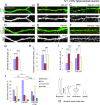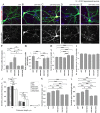Focal adhesion kinase acts downstream of EphB receptors to maintain mature dendritic spines by regulating cofilin activity
- PMID: 19553453
- PMCID: PMC2819391
- DOI: 10.1523/JNEUROSCI.4681-08.2009
Focal adhesion kinase acts downstream of EphB receptors to maintain mature dendritic spines by regulating cofilin activity
Abstract
Dendritic spines are the postsynaptic sites of most excitatory synapses in the brain and are highly enriched in polymerized F-actin, which drives the formation and maintenance of mature dendritic spines and synapses. We propose that suppressing the activity of the actin-severing protein cofilin plays an important role in the stabilization of mature dendritic spines, and is accomplished through an EphB receptor-focal adhesion kinase (FAK) pathway. Our studies revealed that Cre-mediated knock-out of loxP-flanked fak prompted the reversion of mature dendritic spines to an immature filopodial-like phenotype in primary hippocampal cultures. The effects of FAK depletion on dendritic spine number, length, and morphology were rescued by the overexpression of the constitutively active FAK(Y397E), but not FAK(Y397F), indicating the significance of FAK activation by phosphorylation on tyrosine 397. Our studies demonstrate that FAK acts downstream of EphB receptors in hippocampal neurons and EphB2-FAK signaling controls the stability of mature dendritic spines by promoting cofilin phosphorylation, thereby inhibiting cofilin activity. While constitutively active nonphosphorylatable cofilin(S3A) induced an immature spine profile, phosphomimetic cofilin(S3D) restored mature spine morphology in neurons with disrupted EphB activity or lacking FAK. Further, we found that EphB-mediated regulation of cofilin activity at least partially depends on the activation of Rho-associated kinase (ROCK) and LIMK-1. These findings indicate that EphB2-mediated dendritic spine stabilization relies, in part, on the ability of FAK to activate the RhoA-ROCK-LIMK-1 pathway, which functions to suppress cofilin activity and inhibit cofilin-mediated dendritic spine remodeling.
Figures










Comment in
-
EphB maintains dendritic spine morphology through focal adhesion kinase.J Neurosci. 2009 Oct 21;29(42):13091-3. doi: 10.1523/JNEUROSCI.4155-09.2009. J Neurosci. 2009. PMID: 19846695 Free PMC article. No abstract available.
Similar articles
-
EphB receptors regulate dendritic spine morphogenesis through the recruitment/phosphorylation of focal adhesion kinase and RhoA activation.J Biol Chem. 2006 Jan 20;281(3):1587-98. doi: 10.1074/jbc.M511756200. Epub 2005 Nov 18. J Biol Chem. 2006. PMID: 16298995
-
Relapse-Associated Transient Synaptic Potentiation Requires Integrin-Mediated Activation of Focal Adhesion Kinase and Cofilin in D1-Expressing Neurons.J Neurosci. 2020 Oct 28;40(44):8463-8477. doi: 10.1523/JNEUROSCI.2666-19.2020. Epub 2020 Oct 13. J Neurosci. 2020. PMID: 33051346 Free PMC article.
-
State-dependent diffusion of actin-depolymerizing factor/cofilin underlies the enlargement and shrinkage of dendritic spines.Sci Rep. 2016 Sep 6;6:32897. doi: 10.1038/srep32897. Sci Rep. 2016. PMID: 27595610 Free PMC article.
-
Role of LIMK1-cofilin-actin axis in dendritic spine dynamics in Alzheimer's disease.Cell Death Dis. 2025 Jun 3;16(1):431. doi: 10.1038/s41419-025-07741-7. Cell Death Dis. 2025. PMID: 40461464 Free PMC article. Review.
-
Stress and trauma: BDNF control of dendritic-spine formation and regression.Prog Neurobiol. 2014 Jan;112:80-99. doi: 10.1016/j.pneurobio.2013.10.005. Epub 2013 Nov 6. Prog Neurobiol. 2014. PMID: 24211850 Review.
Cited by
-
ARAP1 negatively regulates stress fibers formation and metastasis in lung adenocarcinoma via controlling Rho signaling.Discov Oncol. 2023 Nov 27;14(1):214. doi: 10.1007/s12672-023-00832-x. Discov Oncol. 2023. PMID: 38008882 Free PMC article.
-
Neocortical dendritic complexity is controlled during development by NOMA-GAP-dependent inhibition of Cdc42 and activation of cofilin.Genes Dev. 2012 Aug 1;26(15):1743-57. doi: 10.1101/gad.191593.112. Epub 2012 Jul 18. Genes Dev. 2012. PMID: 22810622 Free PMC article.
-
Ephrin-A5 and EphA5 interaction induces synaptogenesis during early hippocampal development.PLoS One. 2010 Aug 31;5(8):e12486. doi: 10.1371/journal.pone.0012486. PLoS One. 2010. PMID: 20824214 Free PMC article.
-
FAK-Mediated Signaling Controls Amyloid Beta Overload, Learning and Memory Deficits in a Mouse Model of Alzheimer's Disease.Int J Mol Sci. 2022 Aug 13;23(16):9055. doi: 10.3390/ijms23169055. Int J Mol Sci. 2022. PMID: 36012331 Free PMC article.
-
Building Blocks of Functioning Brain: Cytoskeletal Dynamics in Neuronal Development.Int Rev Cell Mol Biol. 2016;322:183-245. doi: 10.1016/bs.ircmb.2015.10.002. Epub 2016 Jan 6. Int Rev Cell Mol Biol. 2016. PMID: 26940519 Free PMC article. Review.
References
-
- Abbi S, Guan JL. Focal adhesion kinase: protein interactions and cellular functions. Histol Histopathol. 2002;17:1163–1171. - PubMed
-
- Andrianantoandro E, Pollard TD. Mechanism of actin filament turnover by severing and nucleation at different concentrations of ADF/cofilin. Mol Cell. 2006;24:13–23. - PubMed
-
- Arber S, Barbayannis FA, Hanser H, Schneider C, Stanyon CA, Bernard O, Caroni P. Regulation of actin dynamics through phosphorylation of cofilin by LIM-kinase. Nature. 1998;393:805–809. - PubMed
-
- Asrar S, Meng Y, Zhou Z, Todorovski Z, Huang WW, Jia Z. Regulation of hippocampal long-term potentiation by p21-activated protein kinase 1 (PAK1) Neuropharmacology. 2009;56:73–80. - PubMed
-
- Bamburg JR. Proteins of the ADF/cofilin family: essential regulators of actin dynamics. Annu Rev Cell Dev Biol. 1999;15:185–230. - PubMed
Publication types
MeSH terms
Substances
Grants and funding
LinkOut - more resources
Full Text Sources
Other Literature Sources
Molecular Biology Databases
Miscellaneous
